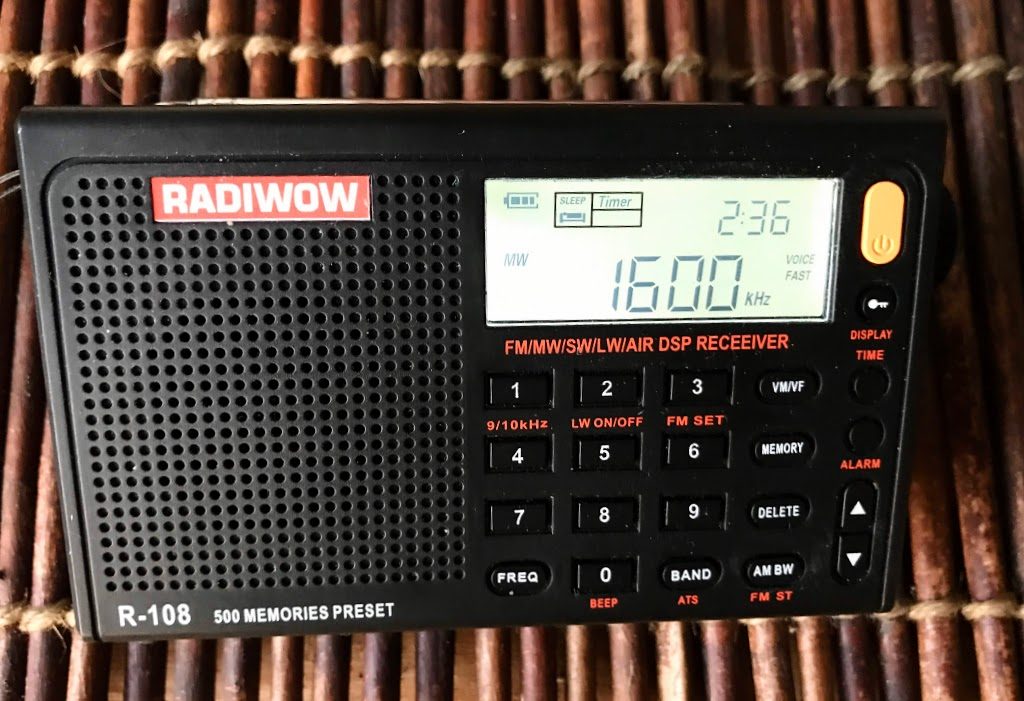As I mentioned in a post yesterday, I’ve been spending time with the Radiwow R-108 in an effort to give it a proper evaluation.
One quirk that has been a little hard to pin down is the occasional DSP birdie on the mediumwave band. [BTW: A “birdie” an unwanted internally-generated noise which, in this case, manifests itself as a variable squeal. Click here to learn more.]
When I first received the R-108, I noticed that each time I turned it on while tuned to the mediumwave (AM broadcast) band, I’d hear a temporary birdie/squeal that would last anywhere from two to seven seconds. After the initial noise, the squeal would go away.
During long (one hour plus) listening sessions, the squeal would sometimes reappear for a few seconds seemingly at random.
Turns out, there’s a pattern that I overlooked.
Yesterday, I turned on the R-108 and a birdie was present on 1600 kHz. Unlike previous listening sessions, the variable squeal was persistent–it didn’t go away after a few seconds. I pulled out my phone and took a quick video (moving quite far away to show that my phone wasn’t the source of noise):
Click here to view on YouTube.
There were two factors I think may have been responsible for the persistent birdie:
- The broadcast signal on 1600 kHz was weaker than normal
- The R-108 battery was at 50% or less
Perhaps the battery has nothing to do with this, other than it might have had a slight negative impact on the receiver sensitivity?
Still, my observations confirm that when the battery is fully-charged, the birdies are overall less prevalent.
I tuned off of 1600 kHz and the the birdie disappeared. Even on 1590 kHz or 1610 kHz where there were only faint signals, there was no birdie.
I should note here that 1600 kHz is home to my favorite regional AM station, so quite often when I turn on the R-108, it defaults to 1600 kHz (hence the reason the birdie seemed to plague me).
I then tuned down the dial in 10 kHz steps until I noticed another persistent birdie on 1200 kHz:
Click here to view on YouTube.
The birdie on 1200 kHz was fainter than the one on 1600 kHz–perhaps half the intensity.
The pattern seemed way too familiar, so I looked into the SWLing Post archives and discovered that the Sangean ATS-405 also had birdies in the same locations on the MW dial.
Here’s a video of the ATS-405 birdie on 1600 kHz:
Click here to view on YouTube.
Obviously, the ATS-405 and R-108 either share the same DSP chip, or the design/implementation is similar.
I checked the R-108’s entire mediumwave band and discovered one more birdie on 800 kHz, although quite faint:
Click here to view on YouTube.
So far, I haven’t had the time to do a full survey of the shortwave bands to see if the birdie is present on HF as well.
I know that there are a few other R-108 owners out there who took advantage of Radiwow’s special pricing on pre-production models to do initial reviews. Please comment if you have also noticed birdies or any other quirks on your R-108 sample.


I am in the market for portable rechargeable radio and am overwhelmed by available products
I have narrowed search and have just a quick question:
which one should I buy for remote mountain area in Tasmania?:
grateful for any thoughts
Tecsun PL-310ET Full Band Radio
or
Tecsun PL-310ET Full Band Radio vs Radiwow R-108 FM Stereo Digital Portable RadioRadiwow R-108 FM Stereo Digital Portable Radio
S/N:R1082019042016 (2019 April Lot?)
Birdies noise is Clean.
Japanese community posted
Radiwow R-108 noise reduction Circuit.
ttps://imgur.com/a/52LLaqz
Plug ‘IN’ into the R-108 earphone jack.
Connect the earphone or speaker to ‘OUT’.
This can reduce white noise and ticking noise.
Two other common quirks are the loss of signal strength on MW, and also on MW we have a ticking sound heard every now and again. Fortunately both have quick fixes. Power off and on to regain signal strength, and toggle the display information (temp, clock, signal/noise) to get rid of the ticking. The ticking seems to be in sync with the display. Todderbert posted a video on these two issues https://youtu.be/hh5Q7NsAS1s Oh, the most annoying issue I have (others have found the same) is a loud popping noise when listening through headphones when switching bands and running seek scan with the up/down buttons. Other than these niggles I’ve been very impressed with the performance of the R-108. It could certainly do with some fixes though! Hopefully we’ll see an improved version.
Gary DeBock (ULDX) has ordered a whole buncha these for loopstick modification experiments.
He just posted that the samples he has received all suffer from birdies and, worse, audio motorboating such as one might hear when turning up the volume on a weak battery (except that is not the cause here).
While the D-808 has proven to have few outright showstoppers and good QC, it looks like the R-108 suffers from design and/or QC issues that potential buyers should take into consideration on a radio having no warranty.
Yes, this has been my experience as well. Sadly, the R-108 has a number of unpredictable birdies especially on the MW band.
Pops up at 1600kHz & 1200kHz? My first guess would be an internal switchmode regulator or converter (i.e. -ve rail from +ve supply). 200kHz or 400kHz is not an uncommon operation frequency for fixed-frequency switchmode chips…
(Depnding on what it’s used for / how it’s loaded, it could also explain the intermittent 2~7 seconds nature of it.)
Wow–you might be correct about that. Thanks!
Thomas